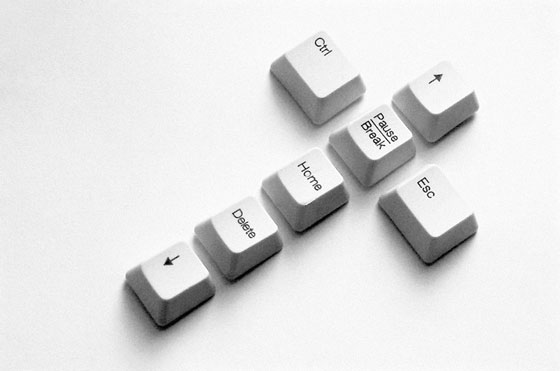|
|
| A Combination of keys – symbol for the feeling of life Stella Pelše, Art Historian Collection of the Latvian Contemporary Art Museum: Ēriks Božis. Press! Press! Press! 2003 | |
 Ēriks Božis. Press! Press! Press! Installation. Wood, glass, plastic. 120x90 cm. 2003. The Latvian Centre for Contemporary database | |
| Ēriks Božis (born 1969) has already earned a constant place among the “second generation” conceptualists of Latvian art. In their understanding, “a work of art is capable of convincing the viewer with the mundane, which must be approximated to natural conditions and endowed with documental precision and proximity to daily life.”1 However, the objects and installations created by Božis can be singled out with their at times delicately concealed errors and moments of distortion, which invite the viewer to question the perception of the surrounding world. In his more conspicuous works Božis has played with scale in the city environment, using elevated phone booths (For Local Calls, 1995), or park benches of differing height (Bench Up, Bench Down, Visby, 2000). Also noteworthy is the visualization of the invisible structures of dust particles, done at micro level (Dust Design, 2006), as well as his collection of bread packaging strips indicating ‘best before’ dates – the temporary cut-off points of the “shelf-life” of consumable goods (Best Before, 2007). Ēriks Božis’ work Sheltering Sky, from his solo exhibition Instruction (2008), with the lopsided suspended ceiling – an imagined sky which hangs over so many office workers conducting their routine life – was nominated for the Purvītis Prize in 2009. His miniature installation Press! Press! Press! is a cross-shaped combination of life-size computer keyboard keys. It was first displayed in the exhibition Adaptation at the Rot¬terman Salt Storage Gallery in Tallinn in 2003. There is quite an in-depth commentary about the work by the author himself: “…a cross made of computer keyboard keys as a symbol of both faith and endeavour, a paraphrase of what nowadays serves as the emergency button or the fast reaction technol¬ogies on which everybody places their efforts and hopes without much critical thought. It is the symbol for a kind of Protestant work culture – a belief that the more effort is invested, the more chances there are of being saved, proving yourself by being hard-working or gaining more blessings through working as hard as possible. I find it pleasantly ironic that my work devoted to the notion of hard-working has been created without any effort. There was no perspiration at all here. These are no longer games with the perception of the physical world, but symbols for the feeling of life in this day and age.”2 The cross of keyboard keys points to the computer as the main tool of our age; one may also observe a certain critical note directed towards the vicious circle of earning and consuming. Of course, a realistic alternative to the self-expression of human existence through work (the monotonous or creative aspects of work is a different topic altogether) is scarcely in evidence, although the popular searches for slowing down the pace of life, unhurried enjoyment of the moments of life, food and relationships – these factors can point to a certain direction. Besides, doubts about technology as the universal solution to all problems (the final victory of democracy, assurance of involvement, the doing away with hierarchies) form another semantic layer of Božis’ work. The choice of keys, which play a specific role in the work done on computer, add to the options for interpretation of the work, as if retreating back from narrowly technological functions to universally human meanings. The Home key is located at the centre (home, a safe place), Esc is on the left (exit, getaway route, retreat, escapism – which can be looked at from various perspectives), Ctrl is on the right (control as a psychological need and one of the basic mechanisms of how the world functions). Moving down from the centre there is the End key and the Delete key, which may remind us of the transitory nature of all things, meanwhile the upwards pointing arrow key placed above the centre invites the viewer to think about ascent and development, whatever it might mean for each person individually. /Translator into English: Vita Limanoviča/ 1 Bužinska, Irēna. Neredzamais cilvēks Ēriks Božis. Studija, 1998, No. 3/4, p. 25. 2 Astahovska, Ieva. User’s Guide or Loser’s Guide. Ēriks Božis: Exhibition Instruction. 29.02– 30.03.2008. Riga: The Latvian Centre for Contemporary Art, 2008, p. 15. | |
| go back | |







